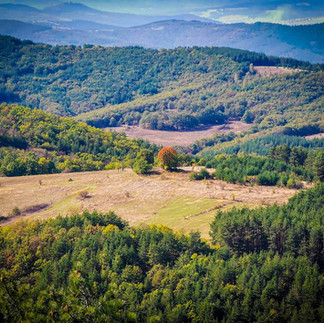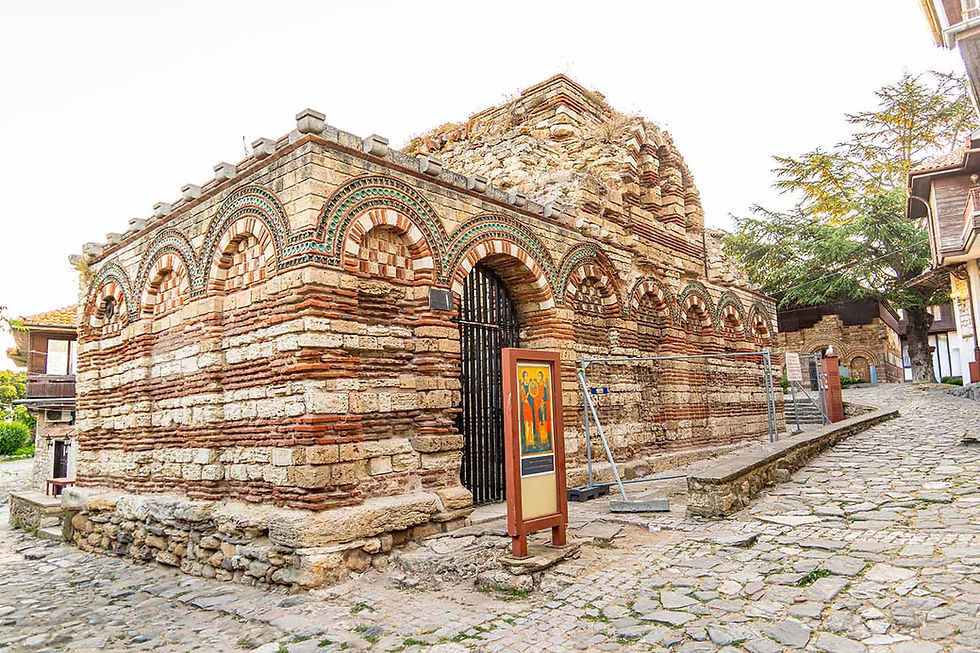Tsepina Fortress
- Stefan Ivanov

- Oct 19, 2022
- 7 min read
Updated: Jan 20
There once was a fortress that no one was ever able to capture in battle.
It rose to the top of the Batashka mountain, and from its walls such a view was revealed all around that one would be left breathless.

The fortress "Tsepina" rises high on a hill in the Western Rhodopes, about four kilometers after the village of Dorkovo, Rakitovo municipality - on the cone-shaped peak Tsepina, which is 1136 meters high. The peak is surrounded on the east by Metoshko dere, on the west by Kostin dol, and on the north it borders on the Karkariysko dere.
The fortress is only accessible from the south, where the actual city was located at the foot.
It is obvious that the place was not chosen by chance - a captivating panoramic view of the entire surrounding area is revealed around. The rock teeth of Pirin can be seen, as well as the closer peaks of Rila.
What is the fortress itself?
The fortress consisted of two parts: a fortified urban core with an inner city (the fortress itself) and an outer city (suburbium or even sub-city).
The suburb, called "polis" by the Byzantine chroniclers, was located at the foot of the fortress. Here were the dwellings of the population. This area has not been surveyed except for one church. The studies are concentrated in the area of the fortress.
The route of the outer fortress walls of the fortified city core with a length of 640 meters and a thickness of 1.8 meters has been revealed. They surround an area of 25 acres with a single entrance in the southeast.
In the northeast corner there was a tower with a polygonal irregular shape.
The walls are reinforced and built of broken stones, soldered with white mortar, with hidden wooden networks of longitudinal and transverse beams (santrachs), typical of the construction of mature feudalism.
The space in the highest and naturally protected part of the urban core was surrounded by walls 142 meters long and 1.8 meters thick. They form the citadel itself, which has an irregular polygonal shape in keeping with the terrain. The walls were built in the same way from rubble stones, joined together with mortar. This self-fortified ensemble, probably the seat of a feudal lord, includes two of the largest water reservoirs. On one of them, which was built on the very top, 8 meters high, with a rectangular shape on the inside and an octagonal shape on the outside, vaulted on top, there was probably a polygonal tower - a donjon with a defensive purpose.
The inner fortress in its western part is connected to the western fortress wall of the fortified city core with a transverse wall. On its south side there were two quartered towers.
Both churches and the other two reservoirs in the southern part of the fortress date from that time.
The study of the fortress "Tsepina" became possible thanks to the numerous information provided by Byzantine sources and concerning the history of Bulgaria.
How do you get to "Cepina"?
If you are traveling on the Pazardzhik - Velingrad road, turn left at the fork for Rakitovo. Keep the road to Dorkovo.
Once you enter Dorkovo, follow the signs that will take you out of the village on a really good and wide road. You will find yourself in a nice parking lot at the foot of the hill and the fortress. Here you can leave your car, and the ascent along the wide and flat path is almost unnoticeable.
The walk is suitable for people of all ages.
On the way up you will enjoy truly unique panoramas that can be seen from this height. The views are phenomenal!
In no more than ten minutes you will already be at the top of the hill. You are greeted by ancient remains of the majestic olden days, as well as information boards that will tell the story of this interesting place.
History
Archaeological studies of the area have established that there was a Thracian settlement here during the early Iron Age, which also existed during the Roman and Late Antiquity eras.
The elevation has been inhabited since the end of the fifth millennium BC. Remains of a Thracian sanctuary of the Besi tribe were also discovered.
After the Christianization of Thrace in the IV century, a large monastery complex arose on the hill, traces of which can still be found today.
Remains of a three-nave basilica from the early Christian era (V-VI century) were found, which was rebuilt into a single-nave church at the time of the First Bulgarian State.
A large number of dwellings were discovered. They were quadrangular buildings, built in the lower part of stones, joined with mud, in a superstructure with adobe, covered on wooden structures with large tiles - tegulas and imbrici.
The apartments are mostly one-piece, some of them connected by corridors. They were built next to each other, without courtyards, but with transitions between them.
In the 9th century, the formed fortress entered the borders of Bulgaria at that time, but later in the 11th century it was conquered by Byzantium.
In 1205, after the magnificent victory of King Kaloyan in the Battle of Edirne, the fortress again became part of Bulgaria.
The greatest flourishing of the fortress "Tsepina", as well as the entire region, was in the first half of the 13th century, when the place was inhabited by the despot Alexii Slav, who separated from the Bulgarian state in 1207-1208 in an independent feudal domain.

Who is Alexii Slav?
Alexii Slav is the son of one of the sisters of the Asenevtsi brothers.
After the death of King Kaloyan in 1207, the throne was taken by his nephew Boril - the son of his other sister and Slav's cousin.
Alexius Slav does not recognize Boril as a ruler.

The dominions of the despot Slav covered a large part of the Rhodopes and the Pirin area. They were rejoined to Bulgaria after the battle of Klokotnitsa in 1230.
With diplomacy and firmness, despot Slav managed to keep his dominions for more than twenty years, despite the complex situation in the Balkans at that time.
He is also known to have been a great builder.

In the Middle Ages, the Rhodopes were called the Slavey Forests. It is assumed that it comes from the name of the despot Slav, from where the name of the city Dospat later derives.
In 1208, Alexius Slav brought his young thirteen-year-old wife Margaret-Isabel, illegitimate daughter of the Latin emperor Henry (Henry) of Flanders, to the fortress "Tsepina".

When the young aristocrat arrives at her husband's austere stone home-fortress on top of the Rhodope Mountains, her mother-in-law Tamara, mother of Alexius, greets her at the threshold.
The girl looked at the impenetrable stone walls and spoke in French:
My God, this is sure to be my grave!
Tamara, who does not understand a word, decides that this is a blessing and replies:
Amen, God willing!

Unhappy and far from home, the young maiden spent hours contemplating the surrounding hills, legend has it.
Unfortunately, she died a year later.
At her request, she was buried on the neighboring peak, so that when the new day dawned, the sun would be the first to shine on her grave.
Later, the despot Slav married again - this time to the niece of the ruler of Epirus - Theodore Comnenus.
In the period 1246 - 1254, the fortress was the property of the Nicaean emperor John Duka Vatsi, but Michael II Assen managed to regain it.
During the time of Ivan Asen II, the fortress once again became part of the Bulgarian state. Its last ruler was Ivan Alexander. In 1256, on the occasion of the conclusion of the Regina Peace Treaty, Theodore II Laskaris wrote:
The magnificent, famous and famous fortress "Cepina" was ceded to my kingdom.
In the second half of the 13th and in the 14th century, the fortress was the subject of fierce disputes between Bulgaria and Byzantium due to its unique location.
A legend tells how "Cepina" was captured by the Turks in the 14th century with treachery.
According to legend, the attackers seized a small child and threatened his mother that they would kill him if he did not tell them how to cross the fortress walls. The frightened woman advises them to cut off the water supply and go through the canals.
When the Ottomans conquered the Rhodopes, the fortress was destroyed.
The population resisted fiercely.
Legends tell of the tragic fate of the Rhodopes during the conquest of this region - the guard of the Rhodopes surrendered after a 9-month siege, after the fall of the "Rakovitsa" fortress near the village of Golyamo Belovo.
Although the fortress was destroyed, during the Ottoman slavery the area was not depopulated. The settlement at its foot continues to exist. The two fortress churches have been renewed, they probably housed monks.
The mass Mohammedanization in 1666 in the Rhodope region, however, put an end to life here.
218 churches and 33 monasteries from Kostenets to Stanimaka were destroyed.
And so, by God's will, the Bulgarians scattered in "Tsepina" - Pope Metodi Draginov concludes his note with pain. Then, most likely, the two churches in the fortress were destroyed, the settlement was abandoned, and life was deserted for a long time.
What can be visited nearby?
In the village of Dorkovo, you can see the magnificent church "St. Ilia".

Near Dorkovo there is a unique site, representing a gathering of bones from over 30 species of animals in one place - Pliocene Park.
8.5 kilometers from Dorkovo (about 14 minutes by car) you can visit the charming town of Rakitovo, where you can see the old clock tower.

20 kilometers from Dorkovo (30 minutes by car) is the Tsigov Chark resort complex and the picturesque "Batak" dam.











































Comments